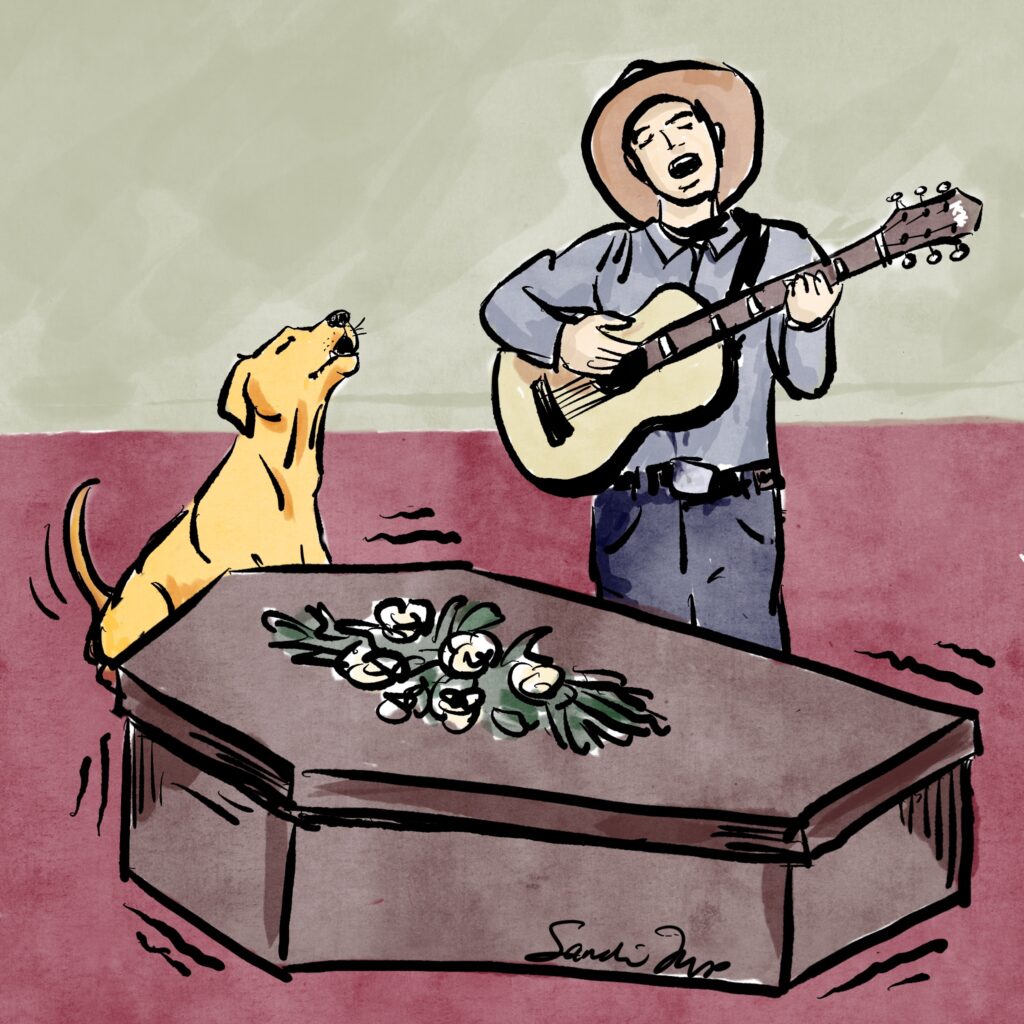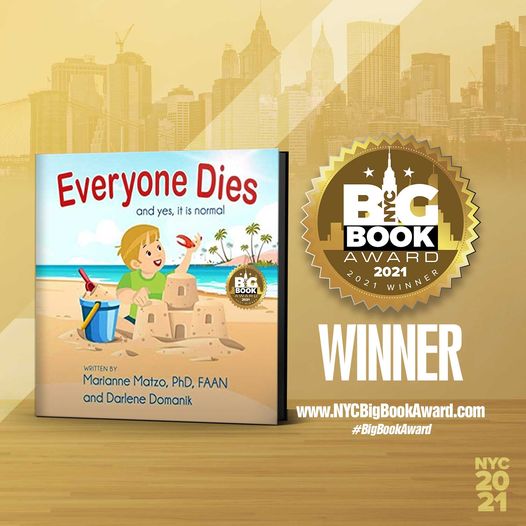Learn strategies to take care of yourself as you accept the course of a loved one’s terminal illness, cope with its challenges, and savor the time they still have left.
A terminal diagnosis for a loved one can turn the world upside-down. Giving care of a also requires good self-care and proper perspective. In this episode you will learn several tools to help you in the rough road ahead.
In this Episode:
- 03:08 – Cheeseburger Pie
- 06:40 – How to Take Care of Yourself as a Terminal Caregiver
- 31:17 – Tales from the Crypt – “Abra Cadaver”
- 34:05 – Does Life Flash Before Your Eyes When You Die?
- 41:36 – Outro
The Caregiver’s Challenge
Caregivers who can accept the course of a loved one’s/care receivers’ illness, learn to cope with its many challenges and then savor the time they still have left with one another are better able to cope with whatever unfolds. How can all caregivers achieve that level of flexibility and adaptation?
Here are some strategies:
- Love them. What about them do you find to be loveable? E.g., their perspective on life that is different from most people’s, politics, culture, music, literature, and movies.
2. Acceptance of the situation. Accept rather than rebel against reality. Don’t look at the situation as a problem but rather as a challenge. What can you do to help your loved one cope and maybe even improve? When you help, you will feel good and that adds to your strength.
3. Look forward. Don’t allow myself to dwell on the past, like “This is what Robbie used to be able to do and now can’t.” Rather, think of each day as a baseline and about how you can move forward from here.
4. Daily writing: 3-minute exercises. Per Albert Ellis’s Rational-Emotive Behavior Therapy, Rational Emotive Behavior Therapy is based on the idea that it is not the things that happen to us that cause our problems; it is our thoughts and thinking patterns that lead to the cognitive, emotional, and behavioral issues that challenge us (Dryden, David, & Ellis, 2010). This idea is captured in the acronym ABC:
- A – The activating event or adversity
- B – Our beliefs about the event, ourselves, and the world in general
- C – The consequences of our emotions and behaviors
Ellis believed that far too much emphasis was placed on the activating events and that most of the consequences were determined by our beliefs…his model helps you identify the thinking that’s dragging you down: “I must solve this. It’s going to be a catastrophe. My whole life is a mess.” Then I write why such demands, such awfulizing, and too-global evaluations are wrong. You may not feel better while writing these three-minute exercises but over time, the positive ideas become more top-of-mind.
5. Scheduling time with your care receiver. Each morning, tell them how much time you can devote to them but that you also need some time for your own work. That starts the conversation, and you can see what your loved one needs from you. If, instead of that, you just play it by ear, you will end up spending all your time with them and you won’t get your own things done.
6. Home care. When possible, hire people who specialize in home care of people with limitations. The website NextDoor can help you find people in your own neighborhood.
7. Support from friends and relatives. It can be very helpful and supportive to have friends who are interested and with whom you can talk about the situation. It helps to remember that you are not doing this alone.
8. Keep yourself healthy. If you have significant physical or mental problems, you can’t be there to help your loved one. You need enough sleep, exercise, and a healthy (preferably plant-based diet). Our resource section for this podcast has an article about how to decrease the amount of time it takes to fall asleep and how to improve the quality of sleep using meditations.
9. Regularly step out of your situation so that you are not constantly immersed in it. Speak with and get together with friends. As a couple, get together with other couples. Engage in your passions so that you can still feel like you.
10. Positive thinking can be negative: Many caregivers are saddled with the belief that staying continuously positive gives them the best chance of warding off the effects of a care receiver’s illness. They refuse to entertain more negative thoughts as if they could be potentially harmful. But positivity not based on reality is self-delusion. It prevents caregivers and care receivers from taking necessary steps to face the challenges of caregiving squarely. It maintains short-term happiness at long-term risk.
11. Negative feelings can be positive: Similarly, some caregivers believe that expressing negative emotions, such as sadness and worry, can increase the stress and guilt felt by care receivers and hurt them, too. (joan and sandwiches). But when caregivers are constantly upbeat, then their loved ones often feel prohibited from expressing any twinge of sadness or anxiety. That doesn’t make them cheerier; it makes them feel more alone with their conditions and emotions. It is better for caregivers to share their negative feelings with care-receivers and consequently draw closer in commiseration.
12. Accepting isn’t despairing: Despair is defined as the complete absence of hope. But that’s not the usual result of acceptance. When a caregiver can reflect upon all the implications of a loved one’s condition, then you are taking command of caregiving to the best of your abilities. Make decisions based on an awareness of the facts. Meet day-to-day problems by generating solutions that are realistic. That doesn’t lessen hope for living a life of the highest possible quality; it increases it.
13. Accepting can be cherishing: Living with acceptance that a loved one is declining doesn’t sap enjoyment from time spent together, it intensifies it. There is something about having an awareness of the care receiver’s vulnerability that focuses the caregiver’s mind and makes time itself more precious. We do our best with eyes fully open. We take in our loved one for as long as we can. Afterward, we cherish them and all we did to try to help them.
Related Podcasts:
References:
- https://news.yahoo.com/brain-scans-dying-man-suggest-203605021.html
- https://blog.frontiersin.org/2022/02/22/what-happens-in-our-brain-when-we-die/
- De Salvo, S., Bramanti, P., & Marino, S. (2012). Clinical differentiation and outcome evaluation in vegetative and minimally conscious state patients: the neurophysiological approach. Functional neurology, 27(3), 155–162.
Resources:
- How to Cope When Your Loved One is Ill: https://www.goodtherapy.org/blog/how-to-cope-when-your-loved-one-is-ill/
- When a Loved One is Terminally Ill: https://www.helpguide.org/harvard/when-a-loved-one-is-terminally-ill.htm
- What is Rational Emotive Behavior Therapy? https://positivepsychology.com/rational-emotive-behavior-therapy-rebt/
- 5 REBT Techniques, Exercises, and Worksheets: https://positivepsychology.com/rebt-techniques-exercises-worksheets/
- Three Minute Therapy is based on Rational Emotive Behavior Therapy (REBT), which was developed by Dr. Albert Ellis in 1955 and is the first and best known Cognitive Behavioral Therapy (CBT). https://www.youtube.com/watch?v=JT8H1pC3sOI
- http://www.threeminutetherapy.com/
- Book can be purchased here: https://amzn.to/3qe4m9x #affiliate
- Get the most out of your neighborhood with Nextdoor: https://nextdoor.com/
- Improve Sleep With 5 Relaxing Guided Meditations For Deep Sleep: https://dailycaring.com/improve-caregiver-sleep-with-5-relaxing-guided-meditations-for-deep-sleep/
Recipe of the Week
If you want to dress up your cheeseburger, try serving it on a pie plate! Get the recipe Here from Southern Living.
:max_bytes(150000):strip_icc():format(webp)/cheeseburger_pie_0_0-1-2cd948dc3b19402ca293bdc33ab4ec48.jpg)


https://blog.feedspot.com/palliative_care_podcasts/

As a songwriter, ‘Everyone Dies’ is inviting you to showcase your original work on an upcoming podcast.
There are many wonderful songs that could be played at a funeral. We also know there are songs that could be played, but are cringeworthy (e.g. Ding Dong the Witch is Dead; Another One Bites the Dust; Ring of Fire, etc.).
We are inviting you to send us a recording of two of your original songs (i.e. that could be played at a funeral, one that is appropriate, one that is likely not) to be included in the third half of the ‘Everyone Dies’ podcast. We will include as many artists over the next year (maybe longer if we are enjoying the segment) as possible.
What we need:
Go to this link, fill out the form and submit it along with your two original songs in .wav or .mp3 format (i.e. two original songs that could be played at a funeral, one that is appropriate, one that is likely not). We will screen them and let you know what week your work will be included. We will include all your information in our show notes so people can purchase your recordings.
Everyone Dies: and yes, it is normal!
Everyone Dies (and yes, it is normal) is a story about a young boy named Jax who finds something special on the beach where he and his grandpa Pops are enjoying a wonderful day. Pops helps Jax understand that death is a normal part of life. This book provides an age appropriate, non-scary, comfortable way to introduce the important topic of mortality to a preschool child. Its simple explanation will last a lifetime. Autographed copies for sale at: www.everyonediesthebook.com. Also available at Amazon
Mourning Jewelry

We offer a way to memorialize your loved one or treasured pet with a piece of handmade jewelry. When people comment on it and the wearer can say for example “I received this when my mother died” which opens the conversation about this loss. All our jewelry is made with semi-precious stones and beads, vintage beads, and pearls. You can choose between earrings or bracelets and the color family. Learn More









